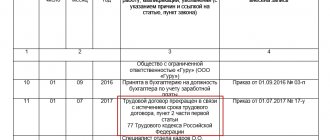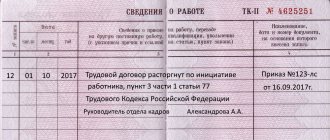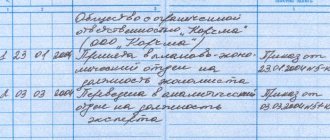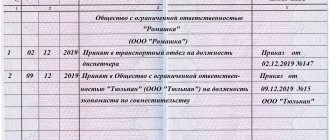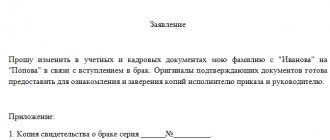Home / Labor Law / Personnel Management / Personnel Records
Back
Published: 08/07/2016
Reading time: 8 min
0
866
Filling out a work book with errors is a fairly rare phenomenon, but it still occurs in practice. After all, even professionals in their field, and even more so newcomers who have recently started working in the personnel department, are not immune from mistakes.
The reasons for incorrectly entering information can be very different. For example, due to inattention, the personnel officer missed something. Or the work book was received by the personnel department and already contained errors. In small companies, filling out such documents is often done by a secretary or other specialist who does not have the relevant experience.
Even one word entered incorrectly or a miscalculation with the numbering of the next entry will be considered an error. Every working citizen must carefully monitor what information has been entered into his work book. For example, the calculation of pension payments depends on the correctness of filling out. Therefore, if an error is detected, you must contact your immediate supervisor or a member of the HR department.
- What does the law say?
- Is it possible to fix it?
- Correction procedure
- What bugs are being fixed? Invalid entry
- Invalid date
- Error in details
- Incorrect award details
- Cover page errors
- Incorrect education record
Common mistakes
Typically, erroneous information appears for objective reasons (change of surname due to marriage, reinstatement of an employee by court decision) or due to the inattention of the specialist who fills out the document. Most often you can notice:
- incorrect indication of the worker’s first, patronymic and last name on the title page;
- incorrect dates of hiring, transfer to a new position, dismissal;
- inaccurate job title;
- missing letters, grammatical errors.
Since even one wrong character can cause a dispute when an employee goes to apply for a pension, personnel officers must be extremely careful. You should always check with the employee’s other documents - passport, birth certificate, marriage certificate, education diploma. And if an inaccuracy does creep in, it must be corrected correctly.
Is it possible to fix it?
Errors are not always associated with carelessness or ignorance of the specialist,
filling out work books. Sometimes the need to change and adjust data is required for other reasons. For example, an employee changed her last name after marriage or, conversely, returned her maiden name after a divorce. Such changes must be reflected in all documents, including those related to work activities.
If the corrections are due to inaccurate information on existing education and specialization, and also contain irrelevant personal data, the book must be completely replaced by issuing a duplicate.
It should be noted that a duplicate is issued every time if the corrections concern the title page of the document.
The only exception is a change of surname confirmed by documentation (for example, a marriage or divorce certificate was presented).
Changes and corrections in labor: how to do it correctly
In accordance with Section III of Government Decree No. 225, the employer may correct:
- surname, first name, patronymic;
- date of birth;
- information about education;
- name of the employee’s profession or specialty;
- information about awards.
The main rule of the personnel officer when correcting erroneously entered information is no crossing out. This is only permissible when correcting incorrect information on the title page. In other cases, changes are made by recognizing certain entries as inaccurate and making correct ones. In this case, the new data must be certified by the signature of the responsible person and, if available, the seal of the organization or personnel service.
Clause 1.2 of Resolution of the Ministry of Labor of Russia No. 69 specifies exactly how amendments should be made. Here is an example algorithm:
- Indicate the serial number.
- Enter the current date (day, month, year).
- In the next column, write down exactly what information is not true and what it should be replaced with.
- In the last column, indicate the details of the order or document on the basis of which the correction is made.
Please note: this algorithm is relevant for correcting information not only about labor documents, but also about inserts for them.
Sample correction in the work book 2020
Regulatory documents and acts
- Labor Code of the Russian Federation. This is the most important document that you need to rely on when working with labor documents. Particular attention should be paid to the wording and correct indication of articles of the Labor Code of the Russian Federation.
- Rules for maintaining and storing work books dated April 16, 2003
- Instructions for filling out work books dated 10.10.2003.
Read more about filling out the title page here.
Making corrections to entries previously made by another company
Option 1. Correct for another organization
Based on the relevant documents, the employer who discovered or made an inaccuracy himself can correct any section in the work book. An employee is not required to go to the company where he previously worked to correct incorrect data. Moreover, sometimes this is simply impossible. At the request of the worker, changes are made by the responsible person of the organization where he is currently employed.
What documents can confirm the correction of erroneous information? It all depends on the situation. This could be a certificate from the archive, a court decision, or a copy of the document confirming the basis for correcting the data, confirmed by the previous employer. Witness testimony in this case has no legal force.
Option 2. The employee turns to the previous employer for correction.
If a person finds incorrect information in the Labor Code, he can contact his previous employer with a request to correct it. If he is already employed, then he writes an application with a request to give him a work book in order to make corrections to it. Then he brings the document to the human resources department of his previous employer, where he must correct the inaccuracies.
If a person does not have a new job, after the lines with information about dismissal, the former employer writes which entry is considered invalid.
If the ex-employee has already found a job, and new entries have appeared in his employment record, the former employer follows the following algorithm:
- Writes the name of the company.
- Indicates the next entry sequence number and date.
- In column 3, he clarifies which information is incorrect and enters the correct information.
- In the last column enters the details of the base document.
How to make the correct adjustment?
The general algorithm for correcting information about work or awards is as follows:
- In the first column they put the next number, next in order to the number of the last entry;
- In the second column - the date of creation of the corrective entry;
- The third column begins with the words “The entry behind the number ... is invalid”;
- Continue the third column with the correct notation;
- In the fourth column, reference is made to the order containing correct information, and if the order itself was issued in error, then to the details of the order canceling the erroneous one.
Corrections in the work book of an entry made by mistake - sample:
There is an opinion that the phrase “The entry for such and such number is invalid” and subsequent correct information should be recorded in two entries under different numbers. However, experts recognize this approach as incorrect and recommend recording both under the same number.
This follows from the logic of the fact of correction : the phrase about the invalidity of the previous entry must necessarily be supported by a “valid” version, and the “valid” version cannot be entered on its own and become a separate independent entry, because the employee is not rehired or fired, but only repeat the old entry in the correct version.
If it concerns the first page of the TC , where data about the owner is recorded, then the scheme for making adjustments will be as follows:
- An incorrect (or changed, supplemented) entry is crossed out with one thin line;
- Up-to-date information is neatly placed next to it;
- On the cover on the inside there is a reference to the documents that confirm the adjustment;
- The link to the documents is certified by the seal of the organization and signed by the employee responsible for the Labor Code.
Correction in the work book - sample:
Step-by-step scheme for making corrections to the title page of the TC.
Several errors at once
If there are several inaccuracies, each one must be corrected. If they are contained in dates, job titles, information about orders, then the personnel officer makes entries recognizing each of the incorrect formulations as invalid. Then indicates the correct data. It is also possible to correct several incorrect ones with one entry.
Sample correction of an entry in the work book 2021, if you need to cancel the last two marks
Results
The most common mistakes that are most often made by HR employees or employers were analyzed using examples other inaccuracies , but they are corrected according to the same scheme.
Ideally, there should be no at all. Their presence is an unpleasant fact for the owner of the work book and spoils the document . Secondly, often mistakes go unnoticed and uncorrected , and sometimes unscrupulous personnel officers see that they have made a mistake, but do not attach much importance to it.
Subsequently, the employee may face various problems , for example, his work experience is declared invalid when calculating a pension or he is not even accepted into a new state, citing the fact that the name in the work book does not match the name in the passport.
A responsible businessman will never allow himself to be negligent in filling out personal documents for his company’s employees.
Corrections on the title page
All incorrect information on the title page is simply crossed out. The exact version, certified by signature and seal, is indicated next to it. This applies to cases where an employee has changed personal data, as well as situations where an error was made due to the inattention of the person who filled out the document.
It is recommended that the correction of the full name. employee on the title page was made by the employer who created the work book. Because only he can know exactly in whose name he issued this document. To avoid problems with assigning someone else’s labor code, the employee should be sent to the very first employer. If the company is liquidated or refuses to correct inaccuracies, the employee can go to court and demand that this work book belong to him.
If you need to indicate a new specialty or additional education on the title page, you do not need to cross out anything. In this case, put a comma in the required line and write new data.
Peculiarities
As already mentioned, errors are possible both on the title page of the work book and on its subsequent pages. are resolved in different ways.
Information on the title page
If you barely had time to open the book and immediately made a mistake on the most important - title - page, it should be torn and thrown away , starting on a new one. But there are often situations when the work book already contains information on subsequent pages, moreover, they are certified, and the personnel officer must make corrections to the title page.
The legislation and rules for maintaining such documents do not establish any specific recommendations in these cases.
Therefore, it was decided to act according to certain instructions .
So, imagine that it is necessary to change the first name, last name, patronymic or date of birth of an employee.
In this case, the correction is carried out by the personnel officer only on the basis of the submitted documents .
These may be a citizen’s passport, a certificate of change of surname/name/patronymic, a certificate of marriage or divorce. In the work book you must indicate the number and date of the required document.
An entry that has become invalid is crossed out with a pen - one solid line . the entire date is still . The correct information is written next to it. And clarifications from the documents are included on the cover of the work book from the inside . The signature of the authorized person and the stamp are also placed there .
Example 1
Antonova Lidiya Konstantinovna got a job on November 18, 2003. her work book and wrote down all her personal data on the title page. A year later, on December 6, 2004, Lidia Konstantinovna took her husband’s surname because she got married.
Now she has become Samoilova. In this situation, the HR department employee needs to act like this: Cross out . Next to it, in the same line, write : “Samoilova.”
On the inside cover at the top write : “The surname “Antonova” has been changed to the surname “Samoilova” on the basis of marriage certificate series ASh No. 232005, issued by the Kursk branch of the Civil Registry Office on December 6, 2004. HR Department Inspector Z.M. Metlyaeva. (Signature stamp).
Question regarding a misspelled first or middle name (even though the employee did not officially change them). This also happens, especially if two names sound almost the same, for example, Sophia and Sofia, Natalya and Natalia.
A person can be called differently, but the only correct option . The same applies to patronymics: how often do we confuse “Gennadievna” and “Gennadievna”, “Valerievna” and “Valerievna”.
So that a person does not have any troubles when, say, he applies for a retirement pension, there should not be any flaws left in his work book.
However, the law does not provide rules for correcting such nuances.
If the first name, last name or patronymic was written with an error when opening the work book, then the latter is destroyed and replaced with a new one (a normative act is drawn up about this).
If the mistake was discovered after the book was filled with entries in the sections and the person had time to change his workplace, the error cannot be corrected .
There is only one way out in such a situation - to contact the judicial authorities so that the document is recognized as belonging to this particular employee, and not to someone else.
Some employers agree that incorrectly written data on the title page can still be corrected if there is a corresponding document signed by the employer who once made the mistake.
In this case, the incorrect word is crossed out, and the necessary entry is made on the cover of the book, including a link to the document . We must not forget about the signature of the authorized person and the seal. In some cases additionally attributed to "Corrected Sophia to Sophia believe".
Download a sample of making corrections due to a change of surname on the title page.
Example 2
Let's consider another situation. There was an inaccuracy in the writing specialty or profession . This may not be a mistake at all: for example, Igorev A.Z. At the time of getting a job, I only managed to graduate from technical school, and later, while working, I received a university diploma with a specialty in marketing.
But in the book, in the line “Education”, the employer wrote down “secondary professional”, and in the line “Profession, specialty” the entry “Technologist” was made.
This can be corrected as follows: in the line “Education” next to the entry “secondary professional” you need to put a comma, and then add “higher professional”. In the line “Profession, specialty” you should put a comma after the word “Technologist” and add “Marketer”.
Sample of making corrections in connection with obtaining education.
Errors in sections
When errors are identified in sections of the work book, they need to be corrected somewhat differently than on the title page.
You cannot cross out anything , clarifications are made not on the cover, but directly in the sections , you just need to make the correct entry below.
Let's assume that a new person has been hired as a member of the company.
An error was accidentally made when writing the name of the company or division. This entry was made under serial number 3 (it is placed in the 1st column).
Example: Chukavin A.S. was hired as chief specialist of the economics department on 10/06/2014. But the personnel officer wrote down the information incorrectly, indicating a different department :
- column No. 1: serial number 3;
- Column No. 2: date of acceptance to the position – 10/06/2014;
- Column No. 3: name of the company and position of the new employee: Trade
Accepted to the position of chief specialist of the trade department; - Column No. 4: information about the document on the basis of which the entry was made: Order No. 47-k dated 10/06/2014.
The correction must be made as follows:
- column No. 1: serial number 4;
- Column No. 2: date on which the correction is made – 10/07/2014;
- Column No. 3: data on the invalidity of the previous entry: Entry No. 3 is invalid,
accepted to the position of chief specialist of the economics department; - Column No. 4: here you can enter information about the document on the basis of which the incorrect entry was made: Order No. 47-k dated 10/06/2014.
If the inaccuracy was not discovered immediately , but when the employee had already quit and entered another job in another company, then the next serial number , it is written that such and such an entry is invalid, and the true information is entered.
The date you need to put down is not the date when the mistake was made, but the date as of which the corrections were made. Column No. 4 is filled in with information about the document on the basis of which the correction was made.
If a company whose employee once made a mistake in the entry was reorganized , the inaccuracy must be corrected by an employee of the company that received the rights to the previous company.
If the company was liquidated and no longer exists, then the new employer takes on the responsibility of making corrections, focusing on duplicate documents evidencing the person’s employment/transfer.
If the employee was reinstated after the discovery of illegal dismissal, the previous entry (about dismissal) is invalidated , then the phrase “reinstated at his previous job” is written.
If an employee was fired, but they made a mistake in indicating the reason for dismissal, then the previous entry is considered invalid , after which the true information is written down: “dismissed due to...”.
Example
Makeev O.D. was fired from his job. The employer made the following entry: “Dismissed for absenteeism, subparagraph “a” of paragraph 6 of part one of Article 81 of the Labor Code of the Russian Federation. Order dated September 10, 2011 No. 133-k.
Citizen Makeev appealed to the judicial authorities, filing a claim against his employer for entering incorrect information into the book. The court satisfied the plaintiff's request. The employer was forced to correct the entry.
The correction is carried out as follows: “Entry No. 2 is invalid, dismissed at his own request, paragraph 3 of part one of Article 77 of the Labor Code of the Russian Federation” Order No. 387-k dated 02/01/2014.
A sample of making corrections in the “Work Information” section.
Errors in awards records
The third section in the work book is called “Information about awards.” Not everyone has this section containing entries. But for some, it is not only completely filled out , but also with errors.
Errors in awards cannot be crossed out or shaded . Incorrect entries are marked as invalid and the correct entry is entered below.
However, everything is the same as in the “Work Information” section. The date in column No. 2, when entering the phrase “Record No. 5 dated March 14, 2001 is invalid,” is placed not the one to which the clerical error was made , but the one to which the correction is made.
An example of declaring an award record invalid.
Errors in award information
For most employees, this section is empty, since this place contains information about awarded diplomas, certificates, titles, and other awards. Therefore, awards pages often end up with unnecessary information. In this case, the responsible person recognizes the entries as invalid, signs, puts a seal (if any) - in general, acts according to the general rules.
You must act in the same way if there is an inaccuracy in the dates, details of the foundation document, company name, or other data.
What can't be fixed?
It is important to note that the dismissal record must be certified by the seal of the organization. If this was not done on time and further information about employment in another organization follows, then it will not be possible to correct it. It will be quite difficult to enter information about the person responsible for maintaining the book at the previous place of work.
Therefore, it is possible to confirm the authenticity of the dismissal record using a clarifying document. It must be requested from the organization that made the mistake. Otherwise, it will not be possible to confirm the period of work there.
Errors in the form of typos on the title page are quite difficult to correct, since there are indications that corrections and additions are made on the basis of documents. Therefore, many personnel officers decide to leave everything as it is, if the error is not critical. But then the citizen will subsequently have to prove that the document belongs to him. Therefore, the responsible person must fill out the title page as carefully as possible and let the employee review it.
Please note that a work book in which entries on the title page and information about the work are incorrectly corrected is considered invalid.
When can a work book be invalidated?
There are several situations when a Labor Code can be invalidated:
- errors were made during initial filling;
- pages are torn out of the document or they are glued together;
- the document number is blurred or unclear;
- the document contains information (words) not related to the employee’s work activity;
- clarifications in the sections “Information about work” and “Information about awards” are made by crossing out, covering with a proofreader, or in any other way not provided for by law.
In these cases, the employee can receive a duplicate document. All correct information is transferred to it; information about incorrect entries is not duplicated.
Change of profession and type of education
The first work book is filled out for an employee who is just starting his professional path. Over the years of work, a person can graduate from a university and obtain a different specialty.
To enter updated data, additional lines are provided in the title section of the work book. The previous entries are not crossed out, and an additional entry should be made in the second line. No references to educational documents should be made on the left side of the spread.
Responsibility for violating the rules
Since the responsibility for maintaining work records rests with the employer, he is also responsible for failure to comply with the established procedure. Responsibility for violations when making entries in the work book is provided for in Article 5.27 of the Code of the Russian Federation on Administrative Offences. An organization can be fined in the amount of 30 to 50 thousand rubles, officials and individual entrepreneurs - in the amount of 1 to 5 thousand rubles. A repeated violation will cost more – up to 70 thousand rubles for a legal entity, and up to 20 thousand rubles for individual entrepreneurs and responsible employees of the employer. They may also be deprived of the right to hold certain positions (disqualified) for a period of one to three years.
We hope you found this article helpful. We recommend that you contact a lawyer to resolve a specific legal problem. The general provisions of the legislation given in the article may not take into account the specifics of each possible case.
The main rule
The main rule of the personnel officer when correcting erroneously entered information: in sections containing information about work and awards, crossing out is prohibited (clause 30 of Resolution No. 225). Remember: you can only cross out on the title page. In other cases, the only possible option is to invalidate the entry and then make a new, correct entry.
New data must be certified by the signature of the responsible person and, if available, the seal of the organization or personnel service.
What documents can be used to confirm the correction of erroneous information depends on the situation. This could be a certificate from the archive, a court decision, a copy of the document that provides the basis for correcting the data, confirmed by the previous employer.
But witness testimony has no legal force.
What to do if an error is discovered by the owner of the work
Don't panic, but immediately take the following actions:
- Collect all documentation that contains correct information;
- Contact management to request correction of erroneous data;
- If the mistake was made at your old place of work, then send an application to the management of that company to provide the necessary documents;
- If the organization that made the mistake has ceased its activities, then you will have to contact the city archive at the place of registration of the company.
Of course, all this takes time, but corrections still need to be made, since the calculation of pensions and a number of other serious issues may depend on this.
